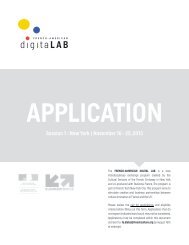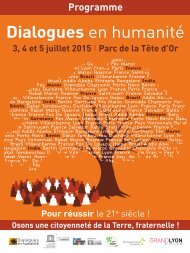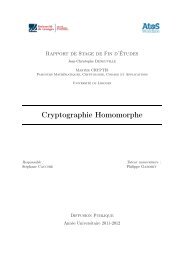REX
BD16_REX
BD16_REX
Create successful ePaper yourself
Turn your PDF publications into a flip-book with our unique Google optimized e-Paper software.
Retours d’expériences Big Data en entreprise<br />
MICROSOFT - CARNEGIE<br />
MICROSOFT - MEET CARNEGIE MELLON’S ENERGY SLEUTHS<br />
An academic, architect, researcher and activist for energy conservation—Vivian Loftness is a champion of biophilic<br />
design. Her workspace, surrounded by light and plants, reflects her passion.<br />
Vivian Loftness is obsessed with sustainability and building performance. Having called many different cities<br />
around the world home — from her birth city of Stockholm, to early years in Los Angeles and Paris, to study and<br />
work stints in Boston, Helsinki, New York City, Cologne, Athens, Ottawa and finally, Pittsburgh, where she is a professor<br />
at Carnegie Mellon’s School of Architecture — Loftness has checked out more than a few buildings close up.<br />
Loftness’ singular passion is for sustainable architectural design and the need to get buildings in our world to a<br />
“zero state” where they have the smallest possible energy footprint without sacrificing comfort. This is no small<br />
feat, and a problem that is technological as much as it is architectural. But advances in technologies such as cloud<br />
computing, data analytics and services such as Microsoft’s Azure Machine Learning are helping Loftness and two<br />
researchers at Carnegie Mellon’s Center for Building Performance and Diagnostics slowly crack the code, one<br />
building at a time, and in ways previously unthinkable.<br />
THE ‘INTELLIGENT WORKPLACE’ - WHERE THE DATA JOURNEY BEGINS<br />
The Intelligent Workplace, which sits atop the Margaret Morrison Carnegie Hall, was established in 1997 as the first<br />
“Living Laboratory” of its kind dedicated to research in building sustainability.<br />
The Robert L. Preger Intelligent Workplace, which sits atop the stunning Margaret Morrison Carnegie Hall, is where<br />
Loftness and 30 researchers and graduate students are studying the impact of a variety of factors on the quality<br />
of built environments. Natural light dominates this space they call “the Living Laboratory,” streaming in through<br />
skylights and wall after wall of expansive windows that offer sweeping views of the campus grounds. Research<br />
students occupy open, collaborative workspaces. Unfinished wooden building models sit on work tables which, like<br />
the rest of the furniture and walls in the lab, are reconfigurable and movable — all in a matter of minutes. Plants<br />
are everywhere, and if you look closely enough, several are wired with sensors, as are the walls and ceilings of<br />
this “living” workspace.<br />
For these researchers, the journey started with really simple questions: How do you give people who work in buildings<br />
a comfortable environment while using the least possible energy? How do you make people accountable for<br />
their own energy footprints? And how can technology assist in that journey?<br />
Senior researchers Bertrand Lasternas and Azizan Aziz work with Loftness, sharing her passion for taking on one<br />
of the most daunting problems facing our generation — How do you make buildings more energy efficient? The<br />
statistics are sobering. Nearly 70 percent of all electricity in the United States goes toward building operations —<br />
heating and cooling systems, lighting, ventilation and plug loads. For these researchers, the journey started with<br />
really simple questions: How do you give people who work in buildings a comfortable environment while using<br />
the least possible energy? How do you make people accountable for their own energy footprints? And how can<br />
technology assist in that journey?<br />
MAKING SENSE OF BUILDING DATA<br />
Not unlike a crew of investigators methodically working their way through evidence at a crime scene, these energy<br />
sleuths have cultivated a healthy respect for data and are capturing it from buildings all across the Carnegie Mellon<br />
campus. They’re about halfway there, drawing data from 40 buildings, with roughly 25 more to go.<br />
Data is how buildings reveal their secrets and to miss one key piece could potentially derail an entire investigation.<br />
“The behaviors of buildings we analyze and the people who occupy them are unique, complex and hard to predict,”<br />
says Loftness. There are students who leave windows open in their dorm rooms during bitterly cold winters when<br />
heat is blasting. There are building managers who leave air conditioning systems running during cool summer<br />
nights. There are offices that enjoy bright daylight but whose staff still leave the lights on all day. And then there<br />
is the challenge of managing “things”— thermostats, computers, microwaves, elevators — as well as analyzing<br />
external factors such as day-to-day fluctuations in weather.<br />
SO MUCH INEFFICIENCY<br />
Loftness conducts a lecture with graduate students at the Intelligent Workplace. Some of her students assist with<br />
the data sleuthing activities.<br />
The large number of variables means one simple thing: Buildings, like those who inhabit them, are living beings.<br />
What are they telling us? More importantly, are we doing enough to listen?<br />
“There is no question that we save 30 percent in most buildings through better awareness of where the energy’s<br />
going, and giving users better controls to adjust for their individual needs while driving down energy usage,” Loftness<br />
says.<br />
The stakes are high and so is the urgency. About 40 percent of CO2 emissions globally come from buildings.<br />
Buildings use technologies and products assembled in hundreds of unique ways, generating literally millions of<br />
Document réalisé par la Société Corp Events - Janvier 2015<br />
64







